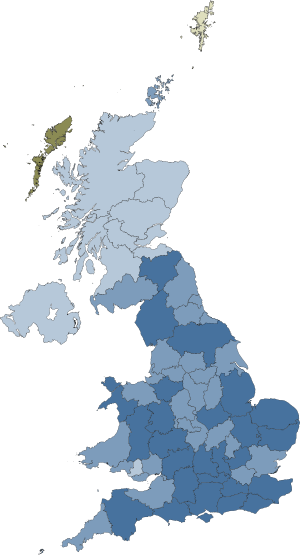This article needs additional citations for verification. (January 2017) |
The United Kingdom European Communities membership referendum was a public vote that took place on 5 June 1975, on whether the United Kingdom should remain a member of the European Communities which was principally the European Economic Community (the Common Market) as it was known at the time. At the time the UK had already been a member of the EC for two and a half years since joining back on 1 January 1973 and was the first ever national referendum of its kind to be held in the country.
This article lists, by voting area, all the results of the referendum, each ordered into national sections.
Under the provisions of the Referendum Act 1975 there was a total of 68 counting areas across the United Kingdom in which counting took place locally. Once the counting areas had officially declared, their results were then relayed by the returning officers to the Chief counting officer Sir Philip Allen who later declared the final result, In England there was a total of 47 counting areas which were made up of the then county council areas of England along with Greater London and the Isles of Scilly. In Wales there was just 8 counting areas which were also made up by the then county council areas. In Scotland the then 12 administrative regions were used as the counting areas with Northern Ireland acting as a single counting area. This meant that of the counting areas the Isles of Scilly with 1,447 eligible voters had the smallest electorate and was also the smallest geographically and Greater London with 5,250,343 eligible voters had the largest electorate and Highland in northern Scotland was the largest geographically with 127,925 eligible voters.
This made for a highly centralised national count with local authorities (district councils) in England and Wales verifying votes locally after polls closed but counting of all totals were only permitted to be held and declared at county council or Scottish regional council level apart from the Isles of Scilly and was not overseen by any independent public body.
Verification of the votes took place after the polling stations closed but counting of the votes did not start until the following morning on Friday 6 June from 09:00 BST, the day after the poll took place and presented unique challenges as large venues were required as there had been no previous experience of counting on such a large and centralised scale and took almost fourteen hours to complete.
© MMXXIII Rich X Search. We shall prevail. All rights reserved. Rich X Search

